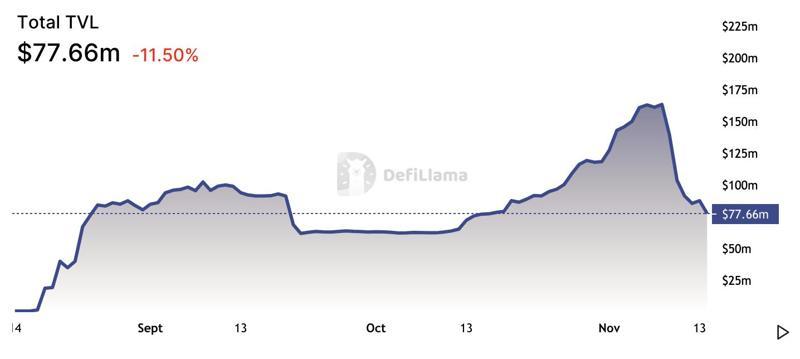Posted on November 22, 2022

- What is Canto?
- How Does Canto Work?
- What Can You Do On Canto?
- CANTO Tokenomics
- How to Add MetaMask to Canto
- How to Bridge Assets to Canto
- How to Stake CANTO
- Projects on Canto
- Conclusion
- Key Takeaways:
- The Team Behind Canto
- Canto Lending Market
- Canto DEX and Liquidity Pool
- NOTE (Canto Unit of Account)
- Manually Through MetaMask
- Automatically Through the Canto DEX
- Canto Longnecks
- Slingshot
- Y2R Finance
- Forteswap
Key Takeaways:
-
Canto is a permissionless Layer 1 blockchain developed with the Cosmos Software Development Kit (SDK) and Tendermint Core.
-
Cantos mission is to offer the primary tools of DeFi (DEX, lending protocol, and decentralized stablecoin) as a Free Public Infrastructure (FPI).
-
It returns power to users by advocating for an environment free of the rent-seeking behavior of most DeFi applications.
Cantos core focus is on its Free Public Infrastructure (FPI), which advocates for DeFi primitives (DEX, lending protocol, and units of account) to be provided as free-to-use public utilities.
Canto is an experimental network with a grassroots ethos. The network did not launch with a foundation, VC funding, pre-sale, or vesting.
With decentralization at its core, Canto launched with the help of a loose organization of contributors native DeFi builders all of whom are interested in delivering on the promise of DeFi.
Prior to the current market turmoil in November 2022, Cantos TVL was experiencing steady growth, with a peak of $163.46M in Total Value Locked.
Source: DefiLlama
So what makes Canto so appealing? Follow along as we dive deeper into Canto, how it works, the Canto lending market, Canto DEX, and liquidity pool, how to bridge assets to Canto, how to add Canto to MetaMask, how to stake CANTO, and projects on Canto.
What is Canto?
Canto is a permissionless Layer 1 blockchain compatible with the Ethereum Virtual Machine (EVM). Its designed to deliver on the decentralized finance (DeFi) promise that new models will be easily accessible, completely transparent, decentralized, and free via a post-traditional financial drive. Canto launched with no core foundation, presale, vesting, or venture backers to be completely decentralized. As of time of writing, Cantos total value locked (TVL) stands at $109.03m, with most of these locked in its DEX and lending protocols.
At its core, Canto leverages the Tendermint Consensus and the Cosmos Software Development Kit (SDK) and is secured by Canto validators. It achieves EVM compatibility through the Ethermint system, which enables an EVM execution environment, further facilitating the deployment of Ethereum smart contracts. These tools include the Canto Decentralized Exchange (DEX), Canto Lending Market (CLM), and NOTE. Canto aims to become the best execution layer for original work through the execution of:
-
Zero fees for liquidity providers (LPs) protocol users, traders, and arbitrageurs can access liquidity freely.
-
Rent extraction resistance Canto believes primary decentralized applications (dApps) like DEXs and lending protocols should have no governance tokens to offer FPI.
-
Minimally reasonable customer capture Primary public primitives lack customer interfaces to enable customer acquisition for Canto protocols.
The Team Behind Canto
Scott Lewis, co-founder of DeFi Pulse and Slingshot Crypto is a contributor and leading force in Canto. The Plex team is another group of contributors, responsible for the development of the network, its Free Public Infrastructure, and the canto.io frontend. A DAO proposal was also recently passed to bring on the B-Harvest team, an established team within the Cosmos ecosystem, as core developers for Canto.
Another notable contributor is NeoBase, who steward the Canto EVM blockchain explorer, and have developed a Canto analytics dashboard featuring details of the protocol including the lending market, as well as covering the Canto DEX and Forteswap.
How Does Canto Work?
The Canto team has identified three core primitives that anchor healthy DeFi ecosystems: Decentralized exchanges (such as Uniswap), lending markets (like Aave), and decentralized units of account (such as DAI). While most of these launch a governance token that extracts rent from future users, Canto has launched these as public utility protocols (also known as Free Public Infrastructure FPI).
This means that Canto lets users engage with its offerings for free, leaving governance to the chain. The Canto DEX will remain ungoverned, and cannot launch a token or implement additional fees. Meanwhile the Canto Lending Market is governed by stakers, who are focused on the growth of the ecosystem and creating an environment that works for developers and DeFi users. Finally, in the case of NOTE, its algorithm that adjusts the interest rate is designed to focus on promoting a less volatile value instead of maximizing revenues, though the interest charged through borrowing NOTE in the CLM is collected by the protocol to further fund public goods.
That said, as Canto is doing a lot of things for the first time, remember to do your own research and limit your financial risk based on your risk appetite.
What Can You Do On Canto?
As mentioned above, Canto has outlined three financial primitives designed to support the Free Public Infrastructure (FPI) that is crucial to its mission of developing new systems that are accessible, transparent, decentralized and rent-free. Well now take a closer look at these three primitives:
Canto Lending Market
Canto Lending Market (CLM) is a mutual pooled lending Compound v2 fork governed by CANTO stakers. The stakers play a vital role in the growth of the Canto ecosystem by creating an ideal environment for developers and users. One way of fostering an ideal ecosystem is eliminating rent extraction at the application layer. CLM accepts liquidity tokens from the Canto DEX as collateral. Users deposit the collateral in a lending protocol as supply, but they are prohibited from borrowing LP assets.
Canto DEX and Liquidity Pool
Because the Canto DEX cant be upgraded or governed, operating on Canto in perpetuity without the ability to launch a token or execute extra fees with time, it prohibits the likelihood of a greedy progression toward rent-seeking behaviors. Essentially, Canto DEX leverages an Automated Market Maker (AMM) mechanism to source liquidity from trading pairs created by LPs. The creators are rewarded with liquidity pool tokens, which they can further collateralize and borrow against.
Canto has put in place a liquidity mining program that issues tokens linearly per block to LPs. Since its launch, the program has ensured adequate liquidity by dividing the genesis block into groups of liquidity mining incentives. The initial token block provided incentives for LPs for the first six months, while the second block served a longer-term period.
NOTE (Canto Unit of Account)
NOTE is an ERC20 token that acts as Cantos unit of account. Initially, the entire supply of NOTE was issued and locked in the CLMs Accountant contract. NOTE is fully backed by collateral lent to CLM, and you can use CANTO, ETH, ATOM, or Canto LP tokens as collateral to borrow NOTE. Besides, automated smart contracts (such as CLMs Accountant contract) regulate the supply of NOTE by lending the collateral (assets that users deposit when minting NOTE) to other borrowers. This is also how NOTE maintains its value, which is centered around US$1.
NOTE is not a stablecoin as it is not pegged to the dollar and can have its own volatility.
CANTO Tokenomics
CANTO is a utility token that facilitates liquidity mining and staking activities on the Canto blockchain. It has a circulating supply of 322M, a total supply of 1B tokens, and a market cap of $109M. The distribution of CANTO (CANTO) is as follows:
-
13.00% is allocated to Contributors
-
2.00% is allocated to Settlers of Canto
-
5.00% is allocated to Future Grants
-
35.00% is allocated to Medium-Term Liquidity Mining
-
45.00% is allocated to Long-Term Liquidity Mining
Some active markets where you can trade CANTO include Canto DEX, Bitget, and MEXC Global.
How to Add MetaMask to Canto
You can add the Canto blockchain to your MetaMask wallet since its compatible with EVM. Assuming you have downloaded and installed MetaMask into your browser, you can add MetaMask to Canto manually through MetaMask or automatically through Canto DEX:
Manually Through MetaMask
-
Log into your MetaMask account.
-
At the upper right hand side of the screen, click on the network dropdown menu you are connected to (it should be Ethereum Mainnet by default).
-
Click Add Network.
-
Copy and paste these RPC details into their respective search bars.
Network Name: CANTO
New RPC URL: https://mainnode.plexnode.org:8545
Chain ID: 7700
Currency Symbol: CANTO
Block Explorer URL: https://evm.explorer.canto.io/
After saving your entries, you can connect to the Canto network anytime through the dropdown menu.
Automatically Through the Canto DEX
-
Go to Canto DEX.
-
Click the Connect Wallet tab to link your MetaMask wallet.
-
Follow the prompts to add the Canto blockchain automatically.
You can cross-check Canto’s RPC details with the one above.
How to Bridge Assets to Canto
After adding MetaMask to Canto, you can bridge tokens across to start interacting with various dApps on the Canto ecosystem. Follow these steps to bridge Ethereum assets to Canto:
-
Visit the Canto Bridge to create a public key for your MetaMask address. Click Generate a Public Key to initiate the process.
-
After clicking the tab, MetaMask will request you to sign a message to confirm the key creation request.
-
Afterward, you can bridge assets from Ethereum to Canto through the Canto Bridge.
How to Stake CANTO
You can stake CANTO through the Canto Staking website. Before staking your tokens, you must connect your web3 wallet and generate a public key. The Canto system will send you an alert if you havent created a public key. The system charges 0.08 CANTO when staking and 1 CANTO when claiming rewards. It distributes rewards every 24 hours.
Projects on Canto
The Canto team has held a couple of hackathons to encourage projects to launch on the Canto network. While Canto is dominated by the Canto DEX and lending protocols, some other projects have surfaced on the platform and are gradually gaining traction within the community. Do note that this article is for educational and informational purposes, and that covering the below projects does not constitute recommendations or financial advice.
Canto Longnecks
Canto Longnecks is an NFT project on the Canto ecosystem featuring unique animated NFT collections. The collections are inspired by emu images and pixelated art and consist of exclusive motivations with a decentralized minting platform. Canto Longnecks community-based approach shows a user-centric project with customer satisfaction at its core.
The first 100 Longnecks minters received free NFTs, which are tradable at NFT marketplaces like Provenant.art and Alto Market.
Slingshot
Slingshot is a web3 trading platform that strives to solve most of the problems crypto traders encounter today while enabling them to get the maximum value of their trades through positive slippage. Essentially, Slingshot aggregates multiple liquidity protocols to offer traders the best market options based on the trading pair they are interested in. Besides, it gives users any positive slippage experienced during the trades, meaning they receive better deals when using Slingshot than on other platforms. Canto users can swap CANTO assets on Slingshot.
Y2R Finance
Y2R Finance is a DeFi Yield Optimizer that enables users to increase their LP assets locked in the CLM. It presents the magic power of auto-compounding with amazing Annual Percentage Yields (APY).
Forteswap
Forteswap is a DEX built on the Conte ecosystem. Users only need to connect their web wallets to swap various Conte assets.
Conclusion
Cantos key differentiating value proposition is its dedication to maintaining a Free Public Infrastructure (FPI) and ensuring it remains rent-free with no governance token or fees instead of maximizing revenue. This is in line with the promise of DeFi, where financial systems are rendered decentralized, accessible, transparent and free.
